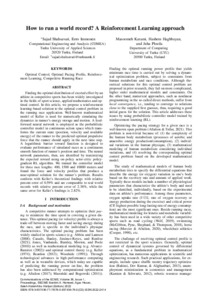How to run a world record? A Reinforcement Learning approach
Haghbayan Mohammadhashem; Immonen Eero; Karami Masoomeh; Shahsavari Sajad; Plosila Juha
https://urn.fi/URN:NBN:fi-fe2022081154615
Tiivistelmä
Finding the optimal distribution of exerted effort by an athlete in competitive sports has been widely investigated in the fields of sport science, applied mathematics and optimal control. In this article, we propose a reinforcement learning-based solution to the optimal control problem in the running race application. Well-known mathematical model of Keller is used for numerically simulating the dynamics in runner's energy storage and motion. A feed-forward neural network is employed as the probabilistic controller model in continuous action space which transforms the current state (position, velocity and available energy) of the runner to the predicted optimal propulsive force that the runner should apply in the next time step. A logarithmic barrier reward function is designed to evaluate performance of simulated races as a continuous smooth function of runner's position and time. The neural network parameters, then, are identified by maximizing the expected reward using on-policy actor-critic policy-gradient RL algorithm. We trained the controller model for three race lengths: 400, 1500 and 10000 meters and found the force and velocity profiles that produce a near-optimal solution for the runner's problem. Results conform with Keller's theoretical findings with relative percent error of 0.59% and are comparable to real world records with relative percent error of 2.38%, while the same error for Keller's findings is 2.82%.
Kokoelmat
- Rinnakkaistallenteet [19250]
